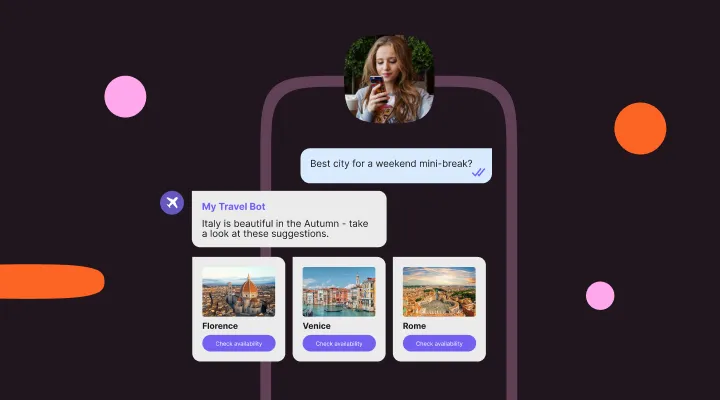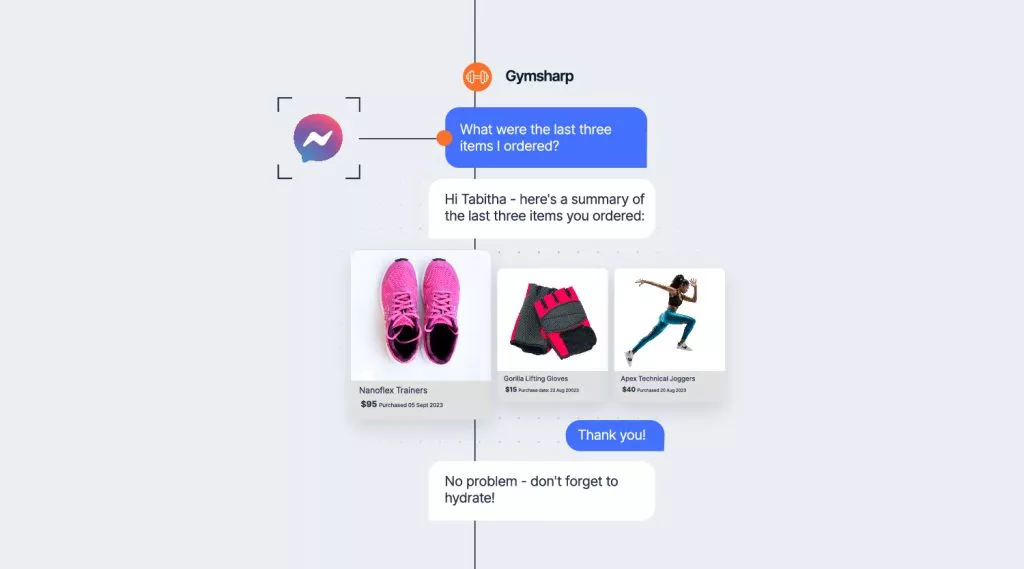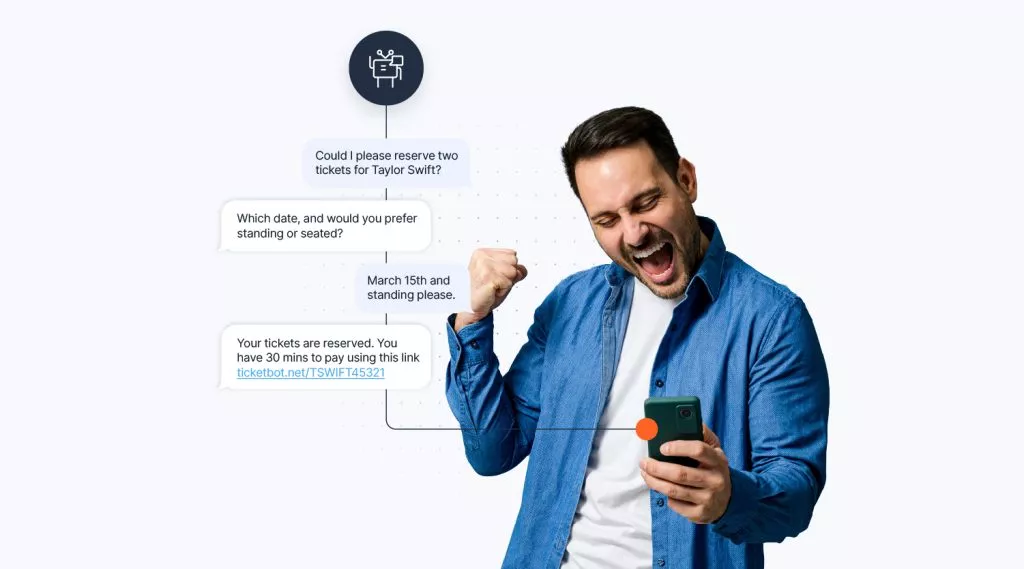Getting started with marketing automation – strategy and examples

If you run a business the chances are that you have a to-do list that you never reach the bottom of.
You may have considered introducing some marketing automation to give you back some precious time. Researching the options is probably in the lower bit of the list that you haven’t got to yet.
We are here to help! In this in-depth article we discuss some of the quick wins for introducing automation to your marketing and messaging strategy covering web, email, SMS, Voice and chat apps like WhatsApp and Messenger.
We also include some marketing automation examples and automated message examples that will hopefully inspire you.
What is marketing automation?
Marketing automation is the use of technology to solve the common business problems associated with limited resources. It enables businesses to make their marketing budgets go further by automating processes that don’t directly require a human, freeing up staff to concentrate on the tasks that do.
Important notifications, replying to customer queries, lead nurturing, and generally engaging with customers and prospects are all activities that automation can help with.
But it goes further than that – automation can also help achieve goals that humans could never do on their own. From 24/7 customer and sales support with chatbots, to AI engines that crunch data in real-time to provide a bespoke and compelling experience for customers based on their history and what they are doing at that moment.
In a nutshell, marketing automation is all about getting maximum value from minimum effort and investment, and here we will share how to go about it.
8 effective marketing automation examples to try
When introducing marketing automation to your business, it is best to work in an agile way – start with the simple and valuable use cases and then build from there. Every business is different – by building, deploying, measuring and then improving you will organically create an automation strategy that is both effective and easy to scale.
Here are some examples of marketing automation that will bring immediate results. If you are an eCommerce business, then we have a whole article dedicated to eCommerce marketing automation.
1. 24/7 triggered responses
These days when a person makes contact with a brand, they expect an immediate response, even if it is an automated message to confirm that the message has been received and will be actioned.
This offers a golden opportunity for brands to make a good first impression and start engaging with the person whether the channel is SMS, email, or a messaging app like WhatsApp, Messenger or Viber.
Studies have shown that messages sent in response to a customer action – whether that is a purchase or registering interest in a service – have open rates x4 higher and click through rates x5 higher than average. This is easily understandable as the key to welcome messages is that they are an immediate response to an action that the person has just taken. The person is thinking about your brand right now and how your products or services can help them. It pays to strike while the iron is hot.
Compare this with standard unsolicited marketing messages that may arrive when the person has their mind on other matters, or may even be asleep or on holiday!
For customers that have signed up to your service or mailing list, you should automate the verification and welcome process for the same reason. This will allow people to get up and running straight away without having to wait for a manual response.

2. Cart abandonment and abandoned registrations
If you are an ecommerce business, then covering the cart abandonment use case should be one of your first priorities. It is both straightforward and an instant revenue generator.
The modern online shopper may browse multiple sites looking for the right product at the right price. They will often add multiple items to their basket across multiple websites so that they can come back and make comparisons. You don’t have to wait for them to make a decision – with well-crafted messages on the right channel you can entice them to complete the purchase on your site.
Offer a discount or free shipping if you like, or simply provide a friendly SMS reminder message that will differentiate you from retailers with similar products.
Abandoned registrations are a bit different but equally important. If you provide a service that requires customers to sign-up, then you want this process to be as easy and streamlined as possible. If people are dropping out of the registration flow, then this means lost revenue. You should identify the pinch points that people are dropping out at and fix them, but also automate messages to anyone who does abandon to re-engage with the process.

3. Automatic customer segmentation
Even the most basic customer segmentation can significantly increase the effectiveness of your marketing campaigns. By using the first party and zero-party data that you have earned from your customers you can ensure people get offers that are relevant to them and respect their preferences. This also ensures that marketing resources are allocated in the most efficient. manner.
The key to effective segmentation is collecting the data you need in a streamlined and transparent manner that demonstrates to customers the benefit to them of providing these details. Designing an overly complex sign-up form that asks for information that isn’t relevant will put people on their guard and may out them off from signing up at all.
By collecting relevant data at the right time, you will build trust and can use marketing automation tools to constantly enrich customer profiles to refine segmentation and targeting.
4. Re-engage with lapsed customers
Also called ‘win-back campaigns’ this is another simple use case that can be very productive. People drift away from suppliers for lots of reasons. Sometimes it is due to price or quality of service, but with commodity products it’s often because the brand has slipped from their mind, and they are shopping with retailers that are more visible.
You can use automation to re-engage with these customers at scale by reminding them of past experiences and showcasing new products that they may be interested in.
Use past purchase history to identify the kind of products and content that they will like, but don’t fixate on this. With automation you can move subjects from one target segment to another until you find something that resonates with them. When done at scale you can achieve significant engagement rates and increased sales.
5. Product recommendations with AI
Amazon’s famous ‘People that bought X also bought Y’ tactic has been the source of many internet memes, but the reason that they have stuck with it for so many years is that it works!
As an Amazon shopper, I love the also-boughts! They’re one of the central ways I find products: either they guide me to additional products people like me tend to want, or they guide me to products similar to but better than the one I’m considering.
Rebecca, author and Amazon fan
It is all about trust – if we are spending our hard-earned cash, we want to know that other people have already done the leg work so we can piggyback on their experience.
Product recommendations have made huge advances with the use of AI – and they aren’t just for businesses with the stock variety and volume of Amazon. Marketing automation solutions that have product recommendation engines baked into them are giving any business the ability to automatically identify the ‘next best product’ for every individual customer and include it in marketing messages to them.

6. Get the most from transactional messages
Transactional messages offer an untapped opportunity to engage with your customers.
In most territories opt-in isn’t required and when purchasing an item customers will expect a confirmation, an invoice, and a dispatch notification when the package is sent.
Whether you are sending these by email, SMS, MMS, or even WhatsApp there are opportunities to brand messages to match current marketing campaigns, automatically personalize every message, and include links to additional resources, for example landing pages with current promotions.
To help you optimize your transactional emails and stay compliant in the European union, we have put to get a useful guide on GDPR regulations and best practice for transactional emails.
7. Introduce a customer service chatbot
You may think that a chatbot is a more advanced automation use case, but it really isn’t. With no-code drag and drop chatbot building tools like our own Answers solution, anyone with internet access can create a very useful chatbot.
A simple rule-based chatbot can answer the majority of simple queries that you get from customers or sales partners. Educate people about your business and your products by including rich media like images, videos and sales material like brochures and catalogues.
The best thing about chatbots is that they scale effortlessly and are active 24/7. That means no more full message inboxes on a Monday morning!
WhatsApp chatbots are a great channel to start with as it is the most widely used chat app in the world, but there are a lot more options. Take a look at our handy guides covering just about every channel where chatbots can be deployed to find out everything you need to know.
8. Mobile app messaging
If you have a mobile ap that someone has taken the time to download, they are showing a commitment to your brand that you should respect and nurture. You can create a highly personal and engaging experience for them without the cost of third-party messaging like SMS and email.
People like to feel part of a privileged group and you should encourage this. Exclusive discounts, first access to new product lines, top-contributor badges and other peer-recognition schemes are effective ways to encourage engagement and loyalty.
You can automate communication with these customers with in-app messages and push notifications but make sure that you follow best practice and don’t overdo it.
We have seen a significant uplift in mobile app messaging on the Infobip platform in the last couple of years. Our recently published Messaging Trends Report for 2024 showed that in North America there was a 18x increase in these types of messages.

How to find the best marketing automation tool for your business
To succeed in automating some of your marketing activities you will need the right tools for the job. There are a LOT of software providers out there and it can be a bit bewildering trying to work out which products are the best fit for your business, and suit your budget.
Most marketing automation suppliers specialize in a particular channel – whether that be email, SMS or chatbots. There are very few suppliers out there that can cover all your channel requirements in one solution.
Does that matter?
It may not when you are just starting out with one or two channels. But when you are further down the road and doing full omnichannel marketing, it can be a pain to deal with multiple support teams, account managers, and pricing models. Not to mention that challenge of keeping databases in sync and accurately reporting on campaign success and ROI across channels.
With this in mind, here are five factors to consider when shopping around for marketing automation tools.

1. Free trials
Look for suppliers that offer a free trial that lets you deploy real workflows and messages. It is the only way you can get a feel for how the product works and to accurately measure the benefits it brings before you commit. Suppliers that offer free trials are also showing that they have confidence in the quality of their product.
2. Transparent and flexible pricing
Look for suppliers that have transparent pricing policies with no huge jumps in tariffs if you want to increase your message volumes or deploy another channel. Prices should include all the features you need, and both the support you require to get up and running, and to scale as you extend your use cases.
3. Scalability
Speaking of scaling, look for tools that make it simple to grow messaging volumes and add additional use cases with no hit to performance or delivery rates. Whether you are sending 100 messages or 100,000, the tool should offer the same quality experience.
4. Multiple channels, one database
This is a really important factor to consider. As a marketer, your most valuable asset is your customer data. Good data allows you to deliver a brilliant and consistent experience across all channels. If your email, SMS and operational databases are out of sync or even completely different, it will be a challenge to automate even the simplest activity.
Imagine a scenario where you have been nurturing a lead for some time and they finally make a high value purchase from you. If your data is not consolidated you may continue to message the customer about the product they just bought. That doesn’t look good.
A tool that covers multiple channels from a single database opens the door to true omnichannel marketing – delivering the right message on the right channel at the optimum time.
5. Reporting capability
Look for tools with great reporting built in. Even better if they provide live stats that allow you to measure ongoing campaigns and make tweaks on the fly, manually or even automatically using the results of AB testing. For example, you can configure multiple versions of the same message with different creatives and CTAs to send to a sample of your audience, automatically track open rates and engagement and then use the ‘winning’ combination to send to the bulk of your campaign audience.
Or go even further and track how different versions of your messages work with different segments of your audience based on their unique attributes – and automatically update your campaigns on the fly.
The combination of good data, live reporting, and the right tech stack make this possible.
Marketing automation success stories
Unicef
The UN agency Unicef depends on donors to fund the important work it does protecting and promoting children’s rights in more than 190 countries.
After noticing a decrease in donor retention and an increase in churn for first time donors, they realized that they needed to optimize their donor communications to significantly increase engagement and conversion. With the sheer size of the donor population, the only way to do this was with automation.
The goal was to:
- Connect with people on their preferred channel
- Enrich communications with personalized content
- Optimize the donor journey to maximize conversion
This was achieved by:
- Consolidating scattered data into a single customer view
- Expanding the channel mix to include Email, SMS, WhatsApp and Voice from a single platform
- Segmenting donors based on their data and journey stage and including them in automated journey campaigns with communications triggered by their actions

Positive results included a 33% decrease in donor churn and a 7.8% increase in donor retention.
Petpetgo
Founded in 2016, Petpetgo is a disruptive e-commerce brand in the pet supplies market in Taiwan. With a product range that pet owners love, they were keen to explore how automation could help them implement new revenue generation strategies to compete better with the incumbent major players.
With the rising costs of social media ads, they wanted to ensure that they could optimize their campaign spend by automatically targeting customers with highly personalized campaigns that satisfied pet owners’ desire to provide the best possible nutrition and products for their beloved animals.
They achieved this by:
- Getting consent to store and use key data like pet type, age, and gender
- Segment customers based on these attributes and other available data
- Create automatic journey campaigns that promoted content and products according to the unique attributes and life stage of each pet.
For example, by simply storing the DOB of a puppy, Petpetgo know when it is due its vaccinations, when is the best time to socialize it, and when it is time to transfer from puppy food to adult food. All opportunities to engage customers with useful and relevant information and make new sales.
The results of introducing marketing automation were significant with a 100% increase in purchase frequency from pet owners.
Bolt
A major player in the ride-hailing industry, Bolt provides a fast and affordable way to get around cities in Europe, Africa, Western Asia and Latin America.
With a growing network of more than 1.5 million drivers across the world, Bolt needed an efficient, touchless, and cost-effective way of enabling drivers to register with them.
The existing web sign up form was too cumbersome and was shown to have a high abandonment rate. Re-engaging with drivers who had dropped out of the process was a time-consuming and manual effort for support agents.
Bolt wanted to introduce a new sign-up channel and use automation to drive efficiencies and increase the percentage of drivers who complete registration.
This is what they did:
- Introduced WhatsApp as a new communication channel
- Implemented an automated WhatsApp chatbot to guide drivers through the sign-up process
- Used live analytics to continually monitor sign-ups and automate messages to any person who abandoned the process

The automated driver registration process led to an amazing 40% increase in sign-up conversion rate and means agents can now handle a higher volume of other inquiries with far fewer repetitive, manual tasks.
Building customer relationships at scale with automation
Automated marketing techniques can help you both find your customers, engage with them, and build loyalty. With a tool like Moments you can do this across multiple channels and offer a personalized and consistent experience.
Create campaigns that run continually and capitalize on every opportunity to connect with customers, globally and 24/7.
Customers appreciate a personal and responsive service – you probably grew your business based on these principles. By introducing marketing automation, you can now deliver the same service at scale.
Find out how conversational commerce can boost your customer experience
Download the Infobrief.
DownloadRelated content

WhatsApp newsletter guide [Create & send WhatsApp newsletter]
A WhatsApp newsletter allows businesses to share updates, promotions, and important information directly within a familiar chat environment.

UM: Turning every marketing campaign into a two-way conversation
How full-service agency UM helps create meaningful conversations between brands and their customers, turning campaigns from something that’s seen into experiences that audiences actively engage with.

How Businesses Use WhatsApp API: Best Use Cases and Examples
Many businesses today ask how to use WhatsApp for business. Customer communication has shifted. Email feels slow. Phone calls feel heavy. Messaging feels natural.












